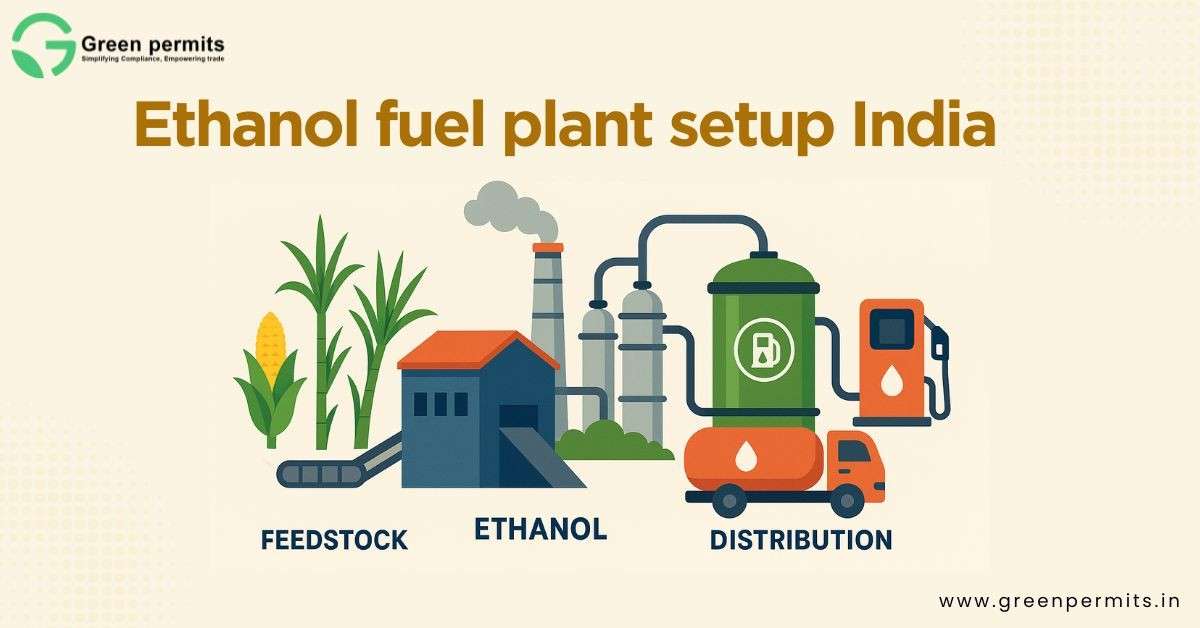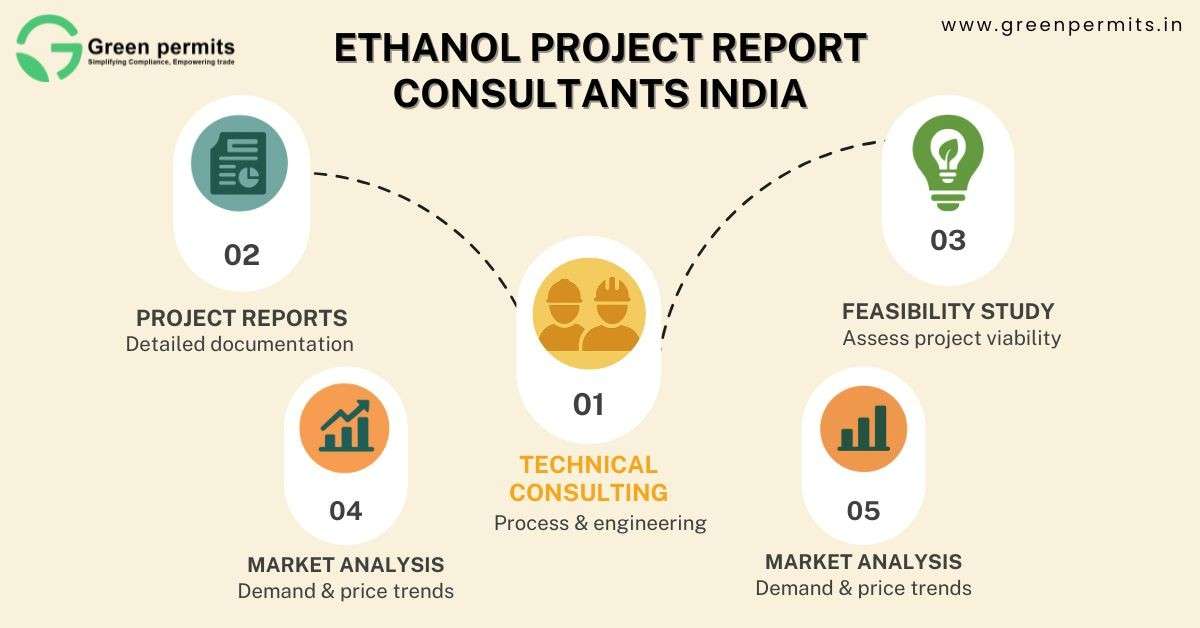India is accelerating its renewable energy transition, and ethanol is becoming the backbone of this effort. With the government targeting 20% ethanol blending by 2025, investors, entrepreneurs, and corporates have a unique chance to enter a high-demand market. In 2023, India produced over 600 crore litres of ethanol — a 45% increase from 2022, showing the strong momentum.
Setting up an ethanol plant is not just about capturing a profitable market. It also supports national priorities like energy security, farmer welfare, and climate commitments. Let’s break down the opportunities, types of plants, approval requirements, and the step-by-step process of starting an ethanol fuel plant in India.
Why Ethanol Fuel Plants Are Gaining Momentum
Ethanol demand in India is not just a passing trend; it is backed by long-term policy frameworks and guaranteed buyers. Businesses investing in ethanol today are aligning with both profitability and sustainability.
Key reasons why ethanol plants are in demand:
- India’s blending target of 20% ethanol in petrol by 2025.
- Ethanol production touched 600+ crore litres in 2023, up 45% from 2022.
- Oil companies such as IOC, BPCL, and HPCL provide long-term procurement contracts at fixed prices.
- Ethanol reduces CO₂ emissions by up to 35% compared to petrol, boosting sustainability goals.
Types of Ethanol Plants in India
Choosing the right type of ethanol plant is crucial for cost, operational efficiency, and regulatory approvals. Different feedstocks and technologies determine both the capital cost and running expenses.
Molasses-based Plants
- Uses by-products of sugar mills
- Requires lower capital, but operations are seasonal
- Investment: ₹80–120 crore for a 60 KLPD plant
Grain-based Plants
- Runs on maize, broken rice, or other surplus grain
- Ensures year-round production and better yields
- Investment: ₹120–150 crore for a 60 KLPD plant
2G (Second-Generation) Plants
- Utilises agricultural residues such as rice straw and bamboo
- Backed by government subsidies, but technology-intensive
- Investment: ₹300+ crore for a 60 KLPD plant
Comparison of Ethanol Plant Types
When planning an ethanol unit, entrepreneurs often compare molasses, grain, and 2G technologies. Each option has distinct cost implications, setup time, and risk factors.
| Plant Type | Feedstock | Investment (₹ Cr for 60 KLPD) | Approvals Needed | Setup Time | Pros | Cons |
|---|---|---|---|---|---|---|
| Molasses | Sugar molasses | 80–120 | CPCB, SPCB, BIS, Excise | 12–15 months | Lower cost, easier setup | Seasonal, feedstock-dependent |
| Grain | Maize, rice, etc | 120–150 | CPCB, SPCB, BIS, Excise | 15–18 months | Year-round, higher yield | Higher capital investment |
| 2G Ethanol | Crop residue | 300+ | CPCB, SPCB, MoEFCC, BIS | 24+ months | Uses agri-waste, strong subsidies | High cost, complex technology |
Step-by-Step Guide to Setting Up an Ethanol Fuel Plant
Starting an ethanol unit requires careful planning, multiple approvals, and investment readiness. A structured roadmap helps entrepreneurs avoid delays and regulatory hurdles.
Steps to set up an ethanol fuel plant:
- Conduct feasibility study and DPR: Analyse site, feedstock, and financial viability.
- Secure land and infrastructure: Choose a site close to feedstock sources, with water and electricity access.
- Obtain approvals and licenses: Environmental clearance, CPCB/SPCB consents, BIS certification, Excise license.
- Arrange finance and subsidies: Apply for concessional loans and viability gap funding for 2G ethanol.
- Install machinery and technology: Set up fermentation, distillation, and dehydration units.
- Run trials and sign OMC contracts: Ensure production meets standards, then secure supply contracts.
Case Study: A Grain-Based Ethanol Success Story
Real-world examples highlight the profitability of ethanol ventures. One such success comes from Uttar Pradesh, where a grain miller diversified into ethanol production.
Highlights of the case study:
- Investment: ₹150 crore for a 60 KLPD plant
- Feedstock: Maize for year-round operations
- Payback period: 4 years, thanks to OMC contracts
- Support: Concessional loan under the Ethanol Interest Subvention Scheme
Financial Incentives and Subsidies
Government support has played a major role in driving ethanol adoption in India. Businesses setting up plants can access several attractive financial incentives.
Major benefits include:
- Interest Subvention Scheme: Low-interest loans for ethanol projects
- Viability Gap Funding (VGF): Special support for 2G ethanol units using crop waste
- Fixed OMC procurement prices: Reduces demand risk for producers
- State-level incentives: Stamp duty waivers, electricity tariff concessions, and tax relaxations
Sustainability & ESG Benefits
Ethanol production offers both financial returns and environmental benefits. For corporates, it is also a strong way to improve ESG reporting and meet sustainability goals.
Environmental and social gains include:
- Reduces greenhouse gas emissions by up to 35% compared to petrol
- Encourages circular economy by utilising waste and by-products
- Creates jobs and boosts rural income for farmers
- Enhances ESG ratings and supports CSR commitments
Frequently Asked Questions (FAQs)
Before starting an ethanol plant, investors often have common questions regarding timelines, approvals, and subsidies.
Environmental clearance, CPCB/SPCB consents, BIS certification, and Excise license.
₹80–120 crore for molasses-based, ₹120–150 crore for grain-based, and ₹300+ crore for second-generation ethanol.
12–18 months for molasses and grain-based units; 24+ months for 2G ethanol.
Interest subvention, viability gap funding, and state-level concessions.
Primarily Oil Marketing Companies under assured contracts.
Conclusion
India’s ethanol program has opened doors for businesses to thrive while supporting national energy and climate goals. The right strategy, approvals, and financing can ensure a profitable venture in this rapidly expanding sector.
At Green Permits Consulting, we assist clients through every stage — from feasibility studies and compliance to licensing and plant commissioning.
📩 Email: wecare@greenpermits.in
📞 Call: +91-78350 06182









